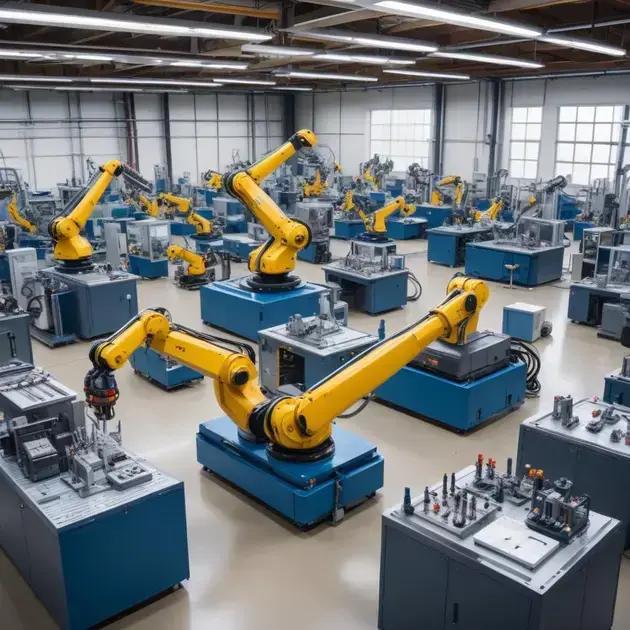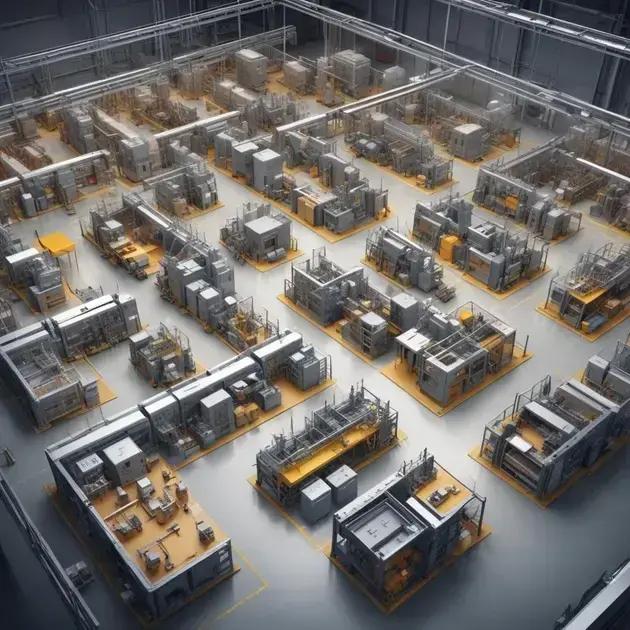Manufacturing methods play a crucial role in transforming raw materials into finished products. With a variety of techniques available, understanding the difference between manufacturing methods, including discrete and process manufacturing, is vital for businesses of all sizes. Efficient production depends on choosing the right method which can significantly impact both costs and quality. Let’s dive deeper into these distinct manufacturing approaches and explore their unique characteristics and benefits…
Understanding Manufacturing
Understanding manufacturing is essential for anyone in the production industry. It involves the conversion of raw materials into finished goods. Manufacturing does not happen in isolation; it requires technology, human labor, and efficient processes. The primary aim is to create products efficiently and economically.
What is Manufacturing?
Manufacturing is the process of making products from raw materials. This can include everything from assembling components to molding materials. Different sectors use various manufacturing methods tailored to their needs.
Types of Manufacturing Methods
There are two main types of manufacturing methods: discrete and process manufacturing.
Discrete Manufacturing
Discrete manufacturing involves creating distinct items. Each item can be counted, touched, and identified. Examples include automobiles, electronics, and furniture. Discrete manufacturing often uses assembly lines for production.
Process Manufacturing
In process manufacturing, goods are produced in bulk. This method typically involves chemical or physical processes. Common examples include food processing, chemicals, and pharmaceuticals. Products are often measured by volume rather than by individual units.
Importance of Manufacturing
The manufacturing sector plays a crucial role in the economy. It creates jobs, drives innovation, and improves living standards. Understanding how these processes work can help businesses optimize their operations and expand their market reach.
The Role of Machinery in Manufacturing

Machinery plays a vital role in the manufacturing process. It enhances efficiency, productivity, and safety in production environments. The right machinery can transform raw materials into finished goods more effectively.
Types of Machinery Used
Manufacturing relies on various types of machinery. Here are some common categories:
- Fabrication Machines: These machines shape materials into specific forms. Examples include laser cutters and CNC machines.
- Assembly Equipment: Used to put together components into final products. Robotic arms and conveyor belts are essential in this category.
- Material Handling Machinery: This equipment helps with transporting raw materials or finished products. Forklifts and automated guided vehicles (AGVs) fall into this category.
Benefits of Machinery in Manufacturing
Using advanced machinery can lead to several benefits:
- Increased Production Speed: Machinery can work much faster than human labor, significantly speeding up production times.
- Higher Consistency: Machines produce items with precision, ensuring uniformity in the final product.
- Improved Safety: By automating dangerous tasks, machinery minimizes the risk of worker injuries.
Challenges with Machinery
While machinery offers many advantages, it can also present challenges:
- High Initial Costs: Investing in machinery can require a significant upfront expense.
- Maintenance Needs: Machines require regular maintenance to function efficiently, which can increase operational costs.
- Technological Updates: Keeping machinery up-to-date with the latest technology is necessary to remain competitive.
Understanding the role of machinery in manufacturing highlights its importance in ensuring streamlined processes and improved product quality.
Discrete vs Process Manufacturing
Manufacturing can be broadly categorized into two types: discrete manufacturing and process manufacturing. Understanding the differences between these two methods is essential for businesses aiming to optimize their production processes.
Discrete Manufacturing
Discrete manufacturing focuses on creating distinct items. These products can be counted as individual units, which are unique and identifiable. Common sectors that use discrete manufacturing include:
- Automotive Industry: Cars and their parts are produced through discrete methods.
- Electronics: Items like smartphones and computers are assembled from various components.
- Furniture: Custom furniture pieces are made individually or in small batches.
Characteristics of Discrete Manufacturing
Some key features of discrete manufacturing include:
- Bill of Materials (BOM): Every product has a detailed BOM outlining all parts and materials needed for production.
- Assembly Lines: Processes often use assembly lines for efficient production, allowing for quick assembly of parts.
- Customization: Offers the ability to customize products based on customer preferences.
Process Manufacturing
Unlike discrete manufacturing, process manufacturing involves creating products in bulk. This method focuses on transforming raw materials into goods through various processes, often involving chemical or physical changes. Common examples of process manufacturing include:
- Food and Beverage: Products like dairy, beer, and snacks are produced in large quantities.
- Chemicals: Industrial chemicals are produced in large batches.
- Pharmaceuticals: Medications and health products are often manufactured using process methods.
Characteristics of Process Manufacturing
Key features include:
- Continuous Production: Often operates continuously, with products being produced in large volumes.
- Batch Processing: Materials are processed in batches rather than individual units.
- Complex Operations: Involves multi-step procedures with strict quality control measures.
Both manufacturing methods have their own advantages and challenges. Choosing the right approach depends on the type of products being made and the production goals of the business.
Financial Impacts of Manufacturing Choices

Manufacturing choices have significant financial impacts on a business. Understanding these impacts can help companies make better decisions that influence profitability, cash flow, and overall sustainability.
Cost Considerations
When choosing a manufacturing method, several costs must be taken into account:
- Material Costs: The price of raw materials can vary widely depending on the manufacturing method. Some methods might require more expensive materials.
- Labor Costs: Different manufacturing processes require varying amounts of labor. Automated processes may reduce labor needs but involve higher upfront costs.
- Overhead Costs: Facilities, machinery maintenance, and utilities can impact overall costs. Choosing the right method can minimize overhead.
Investment in Technology
Investing in new manufacturing technologies can involve significant costs:
- Initial Investments: Purchasing machinery or upgrading technology can be costly but lead to long-term efficiency.
- Training Costs: Employees will need training to operate new technology, which can add to the initial expense.
- Depreciation: As technology ages, it may lose value, affecting financial statements.
Impact on Profit Margins
The choice of manufacturing method can affect profit margins directly:
- Economies of Scale: Large-scale production can lower the cost per unit, increasing profit margins.
- Quality Control Costs: The effectiveness of quality control measures can impact reject rates, affecting profits.
- Time to Market: Faster manufacturing methods can reduce lead times, allowing companies to respond swiftly to market demands.
Long-term Financial Health
Making informed manufacturing choices can contribute to a company’s long-term financial health:
- Cash Flow Management: Effective manufacturing choices can improve cash flow by reducing costs and increasing sales.
- Return on Investment (ROI): Analyzing the ROI of different manufacturing methods can help businesses identify the most profitable options.
- Sustainability: Sustainable practices not only reduce costs but can also attract more customers, positively impacting financial results.
Understanding these financial impacts is crucial for manufacturers looking to optimize their operations and sustain growth.
Choosing the Right Manufacturing Method
Choosing the right manufacturing method is essential for a successful production process. Various factors influence this decision, including product type, production volume, and cost efficiency.
Factors to Consider
When selecting a manufacturing method, consider the following:
- Product Type: The nature of the product can dictate the best manufacturing process. For example, discrete items may benefit from assembly line production.
- Production Volume: High-volume production can justify investments in automated processes, while low-volume jobs might suit manual methods.
- Material Requirements: Different manufacturing techniques work better with certain materials. For instance, a CNC machine is ideal for hard metals, while sheet metal fabrication suits softer materials.
Cost Efficiency
Financial implications should also guide your method selection:
- Upfront Costs: Higher initial investments in technology may pay off in increased efficiency over time.
- Operational Costs: Consider ongoing costs like labor, energy, and maintenance when calculating overall expenses.
- Return on Investment (ROI): Analyze potential ROI for different methods to ensure you choose the most profitable option.
Quality Control
The level of quality control needed can influence your decision:
- Process Variability: Some methods allow for more consistency and less variability, which is vital for product quality.
- Testing Needs: Certain products may require extensive testing, which can affect the manufacturing process.
- Regulatory Compliance: Industries like food and pharmaceuticals have strict regulations requiring specific manufacturing practices.
Flexibility and Scalability
Consider how easily the method can adapt to changes in demand:
- Scalability: Select a method that can scale up quickly if demand increases.
- Customization: The ability to customize products may affect the choice of manufacturing technique.
- Lead Times: Analyze how lead times for different methods compare, especially if market demand fluctuates.
Taking these factors into account will help businesses choose the right manufacturing method that aligns with their goals and operational capacity.




